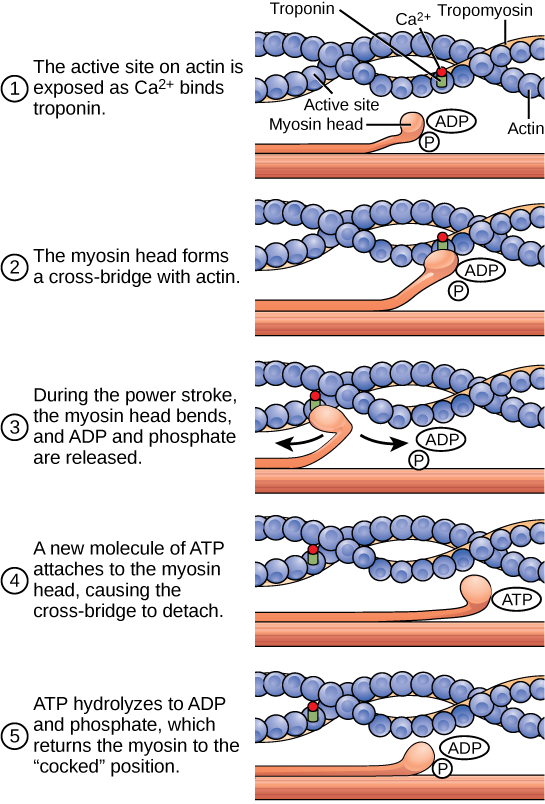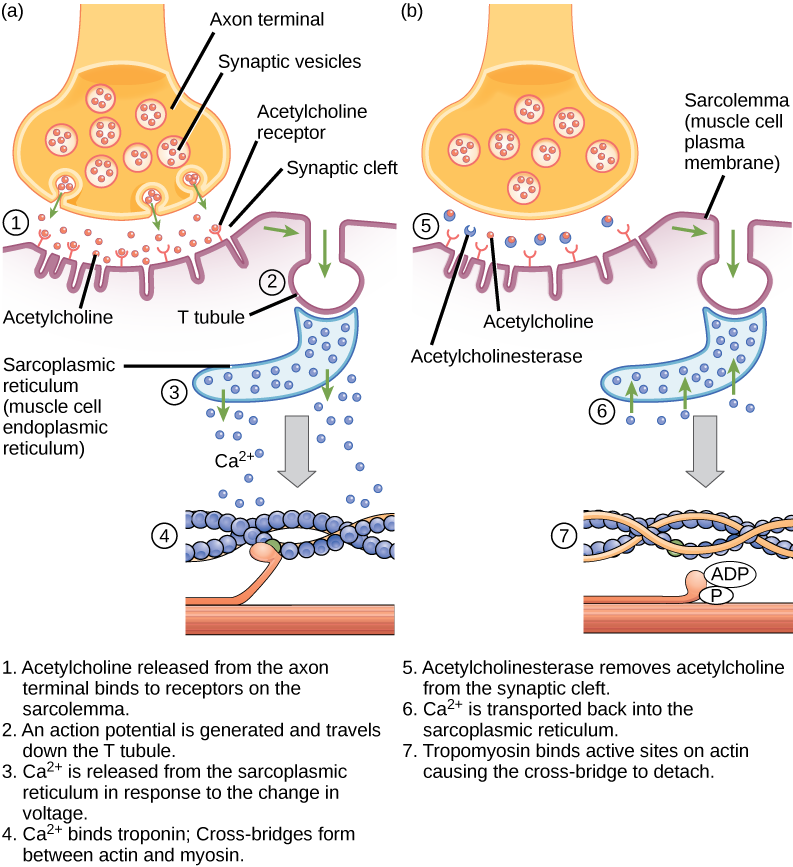| << Chapter < Page | Chapter >> Page > |
If the actin binding sites are uncovered, a cross-bridge will form; that is, the myosin head spans the distance between the actin and myosin molecules. P i is then released, allowing myosin to expend the stored energy as a conformational change. The myosin head moves toward the M line, pulling the actin along with it. As the actin is pulled, the filaments move approximately 10 nm toward the M line. This movement is called the power stroke, as it is the step at which force is produced. As the actin is pulled toward the M line, the sarcomere shortens and the muscle contracts.
When the myosin head is “cocked,” it contains energy and is in a high-energy configuration. This energy is expended as the myosin head moves through the power stroke; at the end of the power stroke, the myosin head is in a low-energy position. After the power stroke, ADP is released; however, the cross-bridge formed is still in place, and actin and myosin are bound together. ATP can then attach to myosin, which allows the cross-bridge cycle to start again and further muscle contraction can occur ( [link] ).

When a muscle is in a resting state, actin and myosin are separated. To keep actin from binding to the active site on myosin, regulatory proteins block the molecular binding sites. Tropomyosin blocks myosin binding sites on actin molecules, preventing cross-bridge formation and preventing contraction in a muscle without nervous input. Troponin binds to tropomyosin and helps to position it on the actin molecule; it also binds calcium ions.
To enable a muscle contraction, tropomyosin must change conformation, uncovering the myosin-binding site on an actin molecule and allowing cross-bridge formation. This can only happen in the presence of calcium, which is kept at extremely low concentrations in the sarcoplasm. If present, calcium ions bind to troponin, causing conformational changes in troponin that allow tropomyosin to move away from the myosin binding sites on actin. Once the tropomyosin is removed, a cross-bridge can form between actin and myosin, triggering contraction. Cross-bridge cycling continues until Ca 2+ ions and ATP are no longer available and tropomyosin again covers the binding sites on actin.
Excitation–contraction coupling is the link (transduction) between the action potential generated in the sarcolemma and the start of a muscle contraction. The trigger for calcium release from the sarcoplasmic reticulum into the sarcoplasm is a neural signal. Each skeletal muscle fiber is controlled by a motor neuron, which conducts signals from the brain or spinal cord to the muscle. The area of the sarcolemma on the muscle fiber that interacts with the neuron is called the motor end plate. The end of the neuron’s axon is called the synaptic terminal, and it does not actually contact the motor end plate. A small space called the synaptic cleft separates the synaptic terminal from the motor end plate. Electrical signals travel along the neuron’s axon, which branches through the muscle and connects to individual muscle fibers at a neuromuscular junction. This junction is functionally similar to a synapse between two nerve cells, allowing a signal from the nerve cell to initiate an action potential in the muscle cell membrane. The action potential in the muscle cell causes Ca ++ to be released from intracellular stores; this elevated calcium concentration triggers the binding of actin and myosin, ATP hyrolysis, and all of the other steps in contraction that are outlined above.
The neurotransmitter released at the neuromuscular junction in most animals is acetylcholine. It is released from the nerve call ending and binds to receptors on the muscle cell plasma membrane ( [link] ); these receptors act as sodium channels when acetylcholine is bound to them. The influx of sodium depolarizes the muscle cell, triggering an action potential in a similar fashion to the action potential found in nerve cells. The acetylcholine is rapidly degraded in the neuromuscular junction by an enzyme called acetylcholinesterase. Various natural toxins (such as the curare used on poison arrows by South American indigenous tribes) and synthetic toxins (including nerve gases and insecticides) target the components of the neuromuscular junction, including both the receptor and the acetylcholinesterase. The deadly nerve gas known as Sarin irreversibly inhibits acetylcholinesterase. What effect would Sarin have on muscle contraction, and how does that effect lead to death?


Notification Switch
Would you like to follow the 'Principles of biology' conversation and receive update notifications?